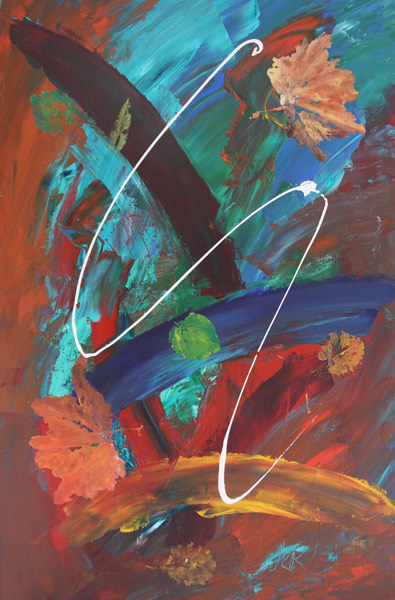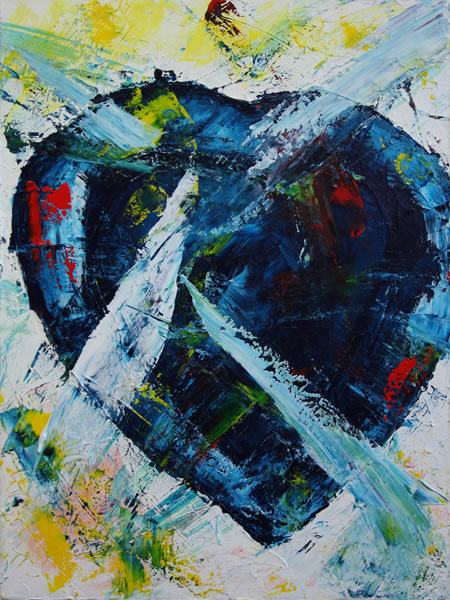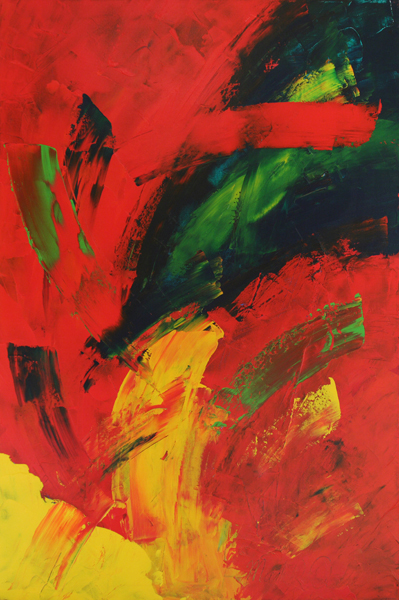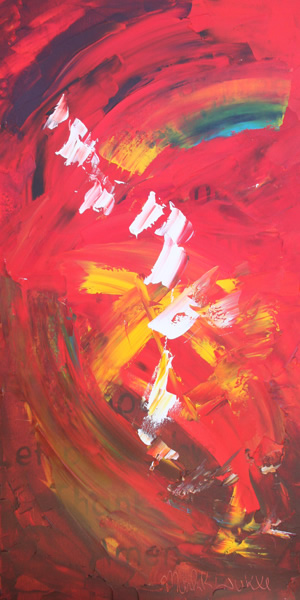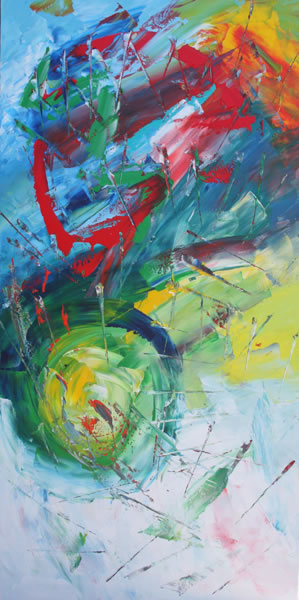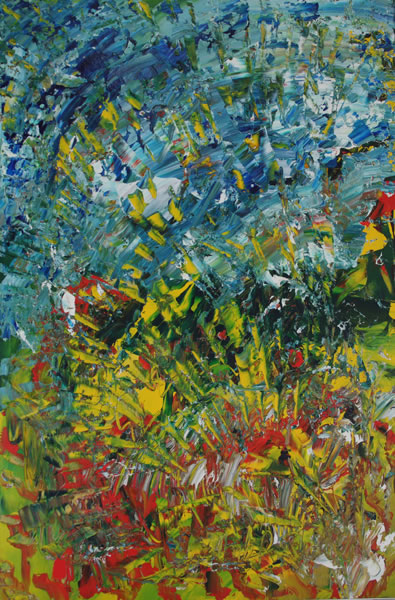|
Mark Dahle's tips for Understanding Abstract Art Abstract paintings use color and form to describe feelings and impressions that often cannot be expressed in words. When viewing abstract art, “What do I feel?” is often a more helpful question than “What do I think?” We are in a culture that thinks verbally, so we often “see” things that can be expressed in words. Often what we see reflects who we are. Sometimes this becomes obvious when other people don’t see what seems plain to us. Sometimes we can convince others to adopt our vision; other times they never “get it” the way we do. I have a painting that I brought to a small church service in Chicago. I did the painting while thinking about the pain I imagine was felt by Native Americans as they witnessed their treaties being broken. I displayed the painting without talking about it. After the worship service, several people came up to tell me how much they liked the painting. One friend told me she liked the painting because it showed God's loving Spirit so clearly. Another friend told me he liked the painting because he could see the gates of hell in it so clearly. Abstract art often is a mirror. When we look, we see ourselves as much as we see what is on the canvas. |
|
|||||||||||
|
I went to grad school in Chicago. When I left, I had two great friends who were still in the Windy City, and I visited them once a year. It wasn't until they also left town that I realized I hadn't really said goodbye to Chicago. But when they left, there was no longer any reason for me to return, at least on a regular basis. As a result, I had to say goodbye to the jogging path along Midway Park and Lake Michigan, to the Medici's spinach pizza and the Nile's appetizers, and to a way of life that had grown familiar. The energy in the paintings didn't surprise me, but the joy and peace reflected in them did. |
|
|||||||||||
|
The Museum Heritage Collection Mark Dahle reserves some of his best paintings of each year for the Museum Heritage Collection. The Museum Heritage Collection is a group of exceptionally beautiful paintings reserved for museums and public venues. Mark's paintings begin at $9,000 for small works on paper. His works on canvas begin at $97,000. Paintings in the Museum Heritage Collection are offered at $1.2 million. Proceeds from the paintings will help establish a museum Mark wants to build for his work. Investors interested in this project may contact Mark directly at: Mark
Dahle Gallery
|
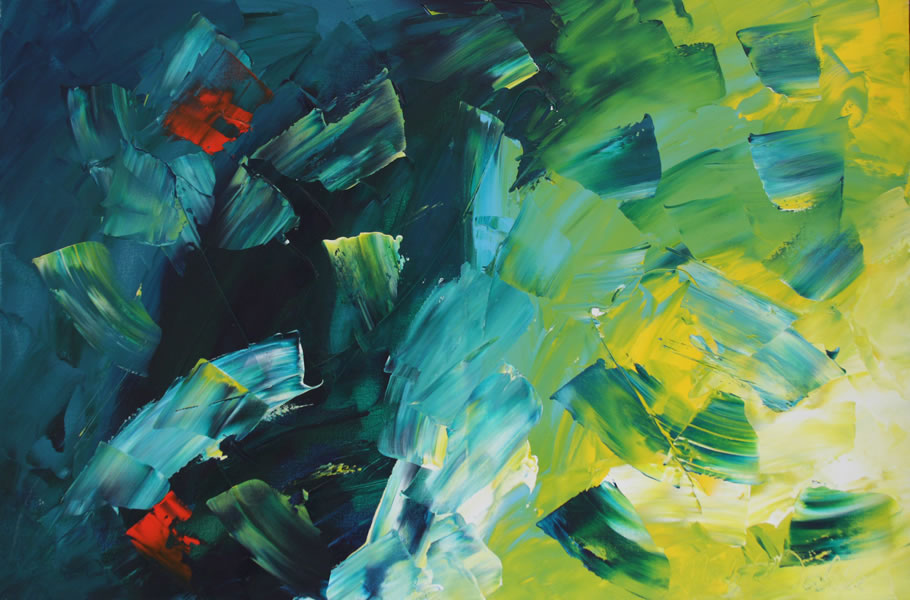
Abstract, a painting in the Museum Heritage Collection. © Mark Dahle 1994 |
|||||||||||
|
Mark Dahle created nine paintings in his Autumn Leaves Series. Paul Joseph Walkowski, an internationally published author and avid art collector living in Boston, wrote for the Artistic Forum, an online fine arts magazine: "Here, in the world of the abstract, I have carved out a niche that interests me. The niche is color – textured, nuanced, moody colors. Think Willem de Kooning’s 1958 work Suburb in Havana, or A Tree in Naples; or Mark Rothko’s Three Triangles. On a more contemporary vein, you might consider Landfield’s For William Blake or Mark Dahle’s stunning Autumn Leaves Series. " Everyone has a Heart Experience. Sometimes two or three. Or more. The paintings in this series help people reflect on the joy and complexity of their own Heart Experiences. |
|
|||||||||||
|
Mark Dahle's Stop And Go paintings use the colors of traffic lights to comment on the pace of life and the decisions we face -- sometimes while stopped and waiting for things to change, sometimes when we have the "go ahead," sometimes at a spot where caution and vigilence are called for. Some have the image of stoplights on them like the painting at the right; some do not but use their colors, like the painting below. Stop And Go #84. © 2005 Mark Dahle. |
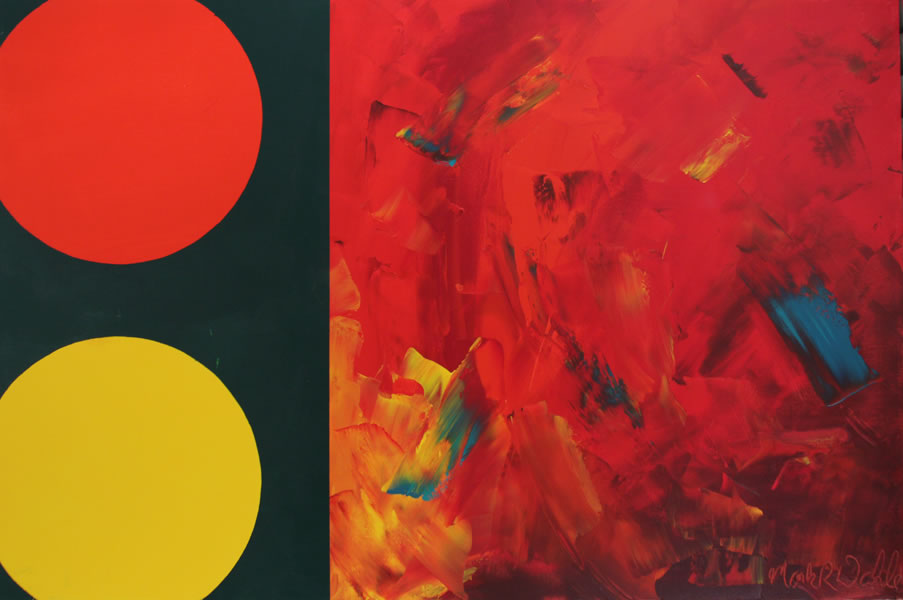
Stop And Go #79. © 2010 Mark Dahle. |
|||||||||||
|
Hidden Prayers In Mark Dahle's Hidden Prayer series, Mark paints a prayer that is then covered up by a painting. Sometimes part of the text can be seen through the painting; sometimes all of the prayer is obscured. The paintings help people reflect on their silent and hidden prayers for others and for nations. Drug violence killed more than 22,000 people in four years in Mexico. People in the government, military, police and judicial system are being targeted. The prayer hidden under the painting on the left: God, set Mexico free from corruption and violence so the people can live joyfully without fear. Let perfect love reign. Thank you. Amen. The prayer hidden under the painting in the center: God, fill Mexico with great leaders who govern by the power of your Spirit and have courage, wisdom, understanding, and love for their people. Thank you. Amen. The prayer hidden under the painting at the right: God, fill Mexico with prosperity that the people might rejoice in you and accomplish their true destiny. Thank you. Amen. |
|
|||||||||||
|
A university professor once asked Mother Teresa if she had a message he could bring back to his students. She took one of his hands, and pointing to his thumb, said "You." Pointing to his index finger, she said "Did." His middle finger: "It." His ring finger: "For."His baby finger: "Me." "You did it for me." The line comes from one of the most compelling stories Jesus tells. In the story, people of all nations are separated into two groups. One group has cared for Jesus when he was hungry and thirsty, when he was sick and in prison, when he was a stranger, and when he needed clothing. The other has not. Both groups are shocked that they have even seen Jesus, let alone cared or not cared for him. But Jesus tells them, "Whatever you did for one of the least of these friends of mine, you did for me.'" The paintings in this series use the image of two hands to reference Mother Teresa's message to the students: "You did it for me." We can use our hands to heal or destroy, to protect or tear down. The series encourages us to use our hands to build up, to feed, to clothe, to protect. |

Two Hands #1. © Mark Dahle 1994 |
|||||||||||
|
Creation: The Fifth Day - In The Air There are many stories of creation. One of the most famous is found in the opening pages of the Bible. The abstract paintings in Mark Dahle's Creation series relate to that story. The painting at the right is titled Creation: The Fifth Day - In The Air. It is based on this part of the story: And God said, . . . "Let birds fly above the earth across the dome of the sky." So God created . . . every winged bird of every kind. And God saw that it was good. God blessed them, saying, "Be fruitful . . . and let birds multiply on the earth." And there was evening and there was morning, the fifth day. (Text reprinted by permission from the New Revised Standard Version of the Bible.) (If you're disappointed that you don't see any birds, check out our article at the top of the page on Understanding Abstract Art.)
Next topic:
Other pages you might be interested in: |




